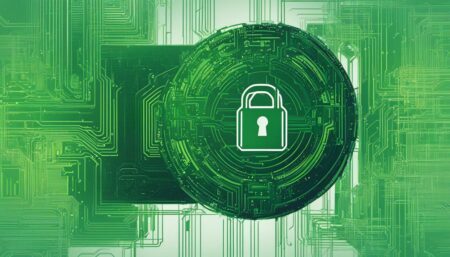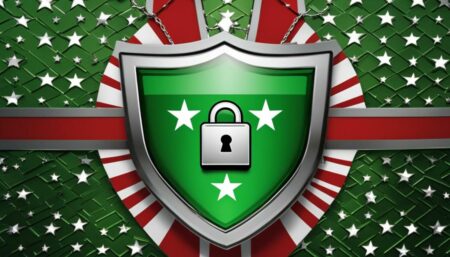Updating your SSL certificate in IIS is crucial for maintaining the security of your server and protecting user data. Without regular updates, your website could be vulnerable to cyber attacks, putting your business and customers at risk. This article will guide you through the easy steps to update your SSL certificate in IIS and provide tips for maintaining a secure server.
Key Takeaways:
- Regular SSL certificate updates are essential to server security.
- SSL certificate renewal is necessary to maintain security.
- Checking the expiry date of your SSL certificate is an important step in updating it.
- Choosing a reliable SSL certificate provider is key to a successful update.
Understanding SSL Certificates and Their Renewal in IIS
SSL (Secure Sockets Layer) certificates play a vital role in securing websites by verifying site ownership and ensuring all data exchanged between the server and client is encrypted. Through the implementation of an SSL certificate, your website becomes more secure and trustworthy, lending credibility to its users.
However, SSL certificates must be renewed periodically to ensure continued protection. Typically, SSL certificates are valid for one to three years, after which they need to be renewed. Failing to renew an SSL certificate can result in the website being flagged as insecure, leading to unhappy users and plummeting search rankings.
Renewing SSL certificates in IIS is relatively straightforward as long as you follow a few simple steps.
Understanding SSL Certificates
An SSL certificate is a digital certificate that allows for the secure exchange of information between the server and client. SSL certificates are issued by trusted third-party Certificate Authorities (CAs) and contain information such as the site’s domain name, the certificate holder’s name, and the certificate’s expiry date.
When a user visits a website protected by an SSL certificate, the user’s browser and the website’s server begin a “handshake” process, during which they agree upon the encryption method they will use to protect the information exchanged between them. This handshake process depends on the validity and authenticity of the SSL certificate, which is used to verify the server’s identity and ensure that the encryption is secure.
Why Renewal is Crucial
Over time, SSL certificates can become outdated, leaving websites vulnerable to hacking attempts and data breaches. As technology progresses, encryption methods and security standards are updated, making it essential for SSL certificates to be renewed periodically. Failure to update certificates can result in the website being flagged as insecure, rendering it less trustworthy to users and reducing the likelihood of attracting new visitors.
In summary, keeping SSL certificates up to date is crucial for maintaining website security, building trust with users, and promoting the overall success of your website.
Checking the Expiry Date of Your SSL Certificate
Regularly checking the expiration date of your SSL certificate is an essential step to ensure the security of your website and user data. Here are the steps to check the expiry date of your SSL certificate in IIS:
- Open the Internet Information Services (IIS) Manager.
- Select the server name and double-click on the “Server Certificates” option under the “IIS” section.
- Look for the certificate you want to check and view its details by double-clicking on it.
- Check the “Validity” section to view the “Valid from” and “Valid to” dates. The “Valid to” date indicates the expiry date of the certificate.
Make sure to check the expiry date of your SSL certificate regularly and plan to renew it well in advance to avoid any potential security issues. It is recommended to renew your SSL certificate at least 30 days before the expiration date to ensure there is enough time for the renewal process.
Choosing a Reliable SSL Certificate Provider
When it comes to updating SSL certificates in IIS, choosing a reliable provider is crucial for ensuring the security of your server. With so many options available, it’s important to evaluate providers and follow best practices to make the right choice.
First and foremost, consider the reputation of the provider. Look for established companies with a proven track record of providing secure and reliable SSL certificates. Additionally, take into account customer reviews and ratings to gain insight into the provider’s level of customer service and support.
Another important factor to consider is the level of encryption offered by the SSL certificate. You want to ensure that the certificate provides a strong level of encryption to protect user data and prevent security breaches.
Finally, be sure to follow best practices when updating SSL certificates in IIS. This includes regularly checking for updates, generating new certificates in advance of expiration, and properly installing and testing the new certificate. By following these best practices and choosing a reliable provider, you can ensure that your server remains secure and trusted by users.
Generating a Certificate Signing Request (CSR)
Before you can obtain a new SSL certificate, you need to generate a Certificate Signing Request (CSR) in IIS. Here are the steps:
- Open Internet Information Services (IIS) Manager from the Start menu on your server.
- Locate the server in the left-hand pane and select “Server Certificates”.
- Click “Create Certificate Request” in the right-hand pane. This will open the “Certificate Request Wizard”.
- On the “Distinguished Name Properties” page, enter the required information for your organization, such as the legal name, country, and state/province.
- On the “Cryptographic Service Provider Properties” page, select “Microsoft RSA SChannel Cryptographic Provider” and the bit length (usually 2048).
- Choose a file name and location to save the CSR.
- Review the information on the final page and click “Finish” to generate the CSR.
It’s important to note that the information entered during the CSR generation process must match the information you provide to your SSL certificate provider when submitting the CSR for a new certificate.
Once you have generated the CSR, you can use it to obtain a new SSL certificate from your chosen provider.
Submitting the CSR and Obtaining the New SSL Certificate
Now that you have generated your Certificate Signing Request (CSR), it’s time to submit it to your SSL certificate provider and receive your new SSL certificate. Here’s a step-by-step process on how to do it:
- Log in to your SSL certificate provider’s website and navigate to the SSL certificate purchase page.
- Select your SSL certificate type and enter the domain name for which you have generated the CSR.
- Paste your CSR into the designated field and double-check to ensure that the information is correct.
- Fill out the necessary contact and billing information and submit your order.
- Your SSL certificate provider will now authenticate your domain and validate your organization before issuing the new SSL certificate.
- Once the validation process is complete, you will receive an email with your new SSL certificate attached in a .zip file.
It’s crucial to work with a reliable SSL certificate provider when updating SSL certificates on your IIS server. This helps ensure that your SSL certificate is trusted by all major web browsers and provides the highest level of security for your users.
After receiving the new SSL certificate, you can move on to installing it on your IIS server.
Installing the New SSL Certificate in IIS
Once the new SSL certificate has been obtained from the Certificate Authority (CA), the next step is to install it on the server. There are different ways to install SSL certificates in IIS, including using the IIS Manager, PowerShell, or the command line. Regardless of the method, the installation process follows similar basic steps:
| Step | Description |
|---|---|
| Step 1 | Open the IIS Manager and select the server name from the connections pane. |
| Step 2 | Click the Server Certificates feature from the main pane. |
| Step 3 | Click the Complete Certificate Request option from the Actions pane. |
| Step 4 | Browse to the location of the certificate file (.cer or .pfx) and provide a friendly name for the certificate. |
| Step 5 | Click OK to complete the installation. |
It’s important to note that some SSL certificates may require additional configuration steps such as binding the certificate to a specific website or enabling HTTPS. These steps can be performed from the IIS Manager by selecting the website and clicking the Bindings feature or enabling HTTPS redirection from the URL Rewrite module, respectively.
Advanced SSL Certificate Installation
If you require more advanced SSL certificate installation options, such as installing wildcard or multi-domain certificates, you can use PowerShell or the command line to execute the installation process. These options provide more control and flexibility over the installation process, especially when dealing with complex certificate configurations.
Tip: Always backup your SSL certificate and private key before performing any installation or configuration changes to your server.
Testing and Verifying the SSL Certificate Installation
Once you have installed the new SSL certificate in IIS, it is essential to test and verify its installation. This step ensures that the certificate is functioning correctly and that users can securely access your website. Here are the steps to follow:
- Open your web browser and enter your website’s URL with HTTPS at the beginning (e.g., https://www.yourwebsite.com).
- If your website loads without any browser warnings, the installation was successful.
- You can also verify the SSL certificate by clicking on the padlock icon in the browser’s address bar. This will display the SSL certificate details, including the certificate’s validity period and the issuing authority.
- Next, you should run a comprehensive SSL test using an online SSL checker tool. This will confirm that your certificate is installed correctly and that there are no vulnerabilities in your website’s SSL setup.
- Make sure to perform regular SSL checks to ensure that your SSL certificate remains valid, and your website is secure.
Testing and verifying your SSL certificate installation is crucial for ensuring that your website is secure, and users can access it without any issues. By following these steps, you can ensure that your SSL certificate is correctly installed, and your website is secure from potential threats and attacks.
Configuring Automatic Certificate Renewal
Configuring automatic SSL certificate renewal in IIS is essential in ensuring that your server remains secure. Rather than waiting for the certificate to expire and manually renew it, you can set up an automated process to handle the renewal for you. This guarantees that there is no downtime and that your website stays secure.
To configure automatic SSL certificate renewal in IIS, follow these simple steps:
- First, ensure that you have installed the Let’s Encrypt extension in IIS
- Open the IIS Manager and navigate to your website
- Click on “SSL Settings” and then check the box next to “Enable automatic renewal”
- Next, select the Let’s Encrypt certificate from the drop-down list
- Click “Apply” to save the changes
Once you have set up automatic renewal, you will receive notifications when the certificate is nearing its expiration date. This enables you to take proactive steps and renew the certificate before it expires.
It is important to note that while automatic renewal guarantees continuity, it does not substitute for regular monitoring of the SSL certificate expiration date. Monitoring ensures that your certificate is always up to date and without any issues.
Regular SSL certificate renewal in IIS demonstrates that your website is secure and gives users confidence in your ability to handle their sensitive data. By setting up automated renewal processes and being proactive in monitoring certificate expiration dates, you can maintain the trust of your users and keep your server secure.
Regularly Monitoring SSL Certificate Expiry
Renewing SSL certificates in IIS is critical for website security. However, simply renewing certificates when they expire is not enough. It is equally important to establish a monitoring system to track certificate expiry dates and ensure timely renewals.
Configuring reminders or alerts to notify you when certificates are about to expire can prevent downtime and ensure continuous protection of user data. Additionally, setting up automatic renewals can further streamline the process and minimize the risk of overlooking certificate renewals.
Regularly monitoring SSL certificate expiry not only ensures your server is secure but also helps build trust with users. By demonstrating a commitment to security and regularly updating certificates, you establish credibility and strengthen user confidence in your website.
Conclusion
Updating SSL certificates on IIS servers is an essential step in securing user data and building trust. Regular updates and certificate renewals are crucial for maintaining server security and ensuring that users can trust your website with their sensitive information.
By understanding the process of updating SSL certificates on IIS, you can take steps to safeguard your server and protect your users. Checking the expiry date of your SSL certificate, choosing a reliable SSL provider, generating a CSR, and installing the new certificate are all important steps that must be followed with care.
Stay Ahead of Certificate Expiry
Once your new SSL certificate has been installed, it is important to test and verify its installation, and then configure automatic certificate renewal to avoid any lapse in security measures. Continually monitoring SSL certificate expiry is crucial for staying ahead of the game and ensuring timely renewals.
Take action now to update your SSL certificate on IIS and secure your server today. Your users will thank you for the peace of mind that comes with knowing their data is safe.
FAQ
Q: Why is it important to update SSL certificates in IIS?
A: Updating SSL certificates in IIS is crucial for server security. Regular updates help protect user data and build trust.
Q: What are SSL certificates and why do they need renewal in IIS?
A: SSL certificates are used to secure websites and ensure encrypted communication. They need renewal in IIS to maintain security and validity.
Q: How can I check the expiry date of my SSL certificate in IIS?
A: To check the expiry date of your SSL certificate in IIS, follow these steps:
Q: How do I choose a reliable SSL certificate provider for updating certificates in IIS?
A: When selecting an SSL certificate provider for updating certificates in IIS, consider factors such as reputation, customer reviews, and industry certifications.
Q: How do I generate a Certificate Signing Request (CSR) in IIS?
A: To generate a Certificate Signing Request (CSR) in IIS, follow these steps:
Q: How do I submit the CSR and obtain a new SSL certificate?
A: To submit your CSR and obtain a new SSL certificate in IIS, follow these steps:
Q: How do I install the new SSL certificate in IIS?
A: To install the new SSL certificate in IIS, follow these steps:
Q: How do I test and verify the SSL certificate installation in IIS?
A: To test and verify the SSL certificate installation in IIS, follow these steps:
Q: What are the benefits of configuring automatic certificate renewal in IIS?
A: Configuring automatic certificate renewal in IIS ensures that certificates are always up to date, reducing the risk of expired certificates.
Q: How can I regularly monitor SSL certificate expiry in IIS?
A: To regularly monitor SSL certificate expiry in IIS, establish a monitoring system and set reminders for timely renewals.
Q: What are the key points to remember about SSL certificate updates in IIS?
A: Regular SSL certificate updates in IIS are essential for server security and maintaining user trust. Secure your servers and build trust with timely updates.





